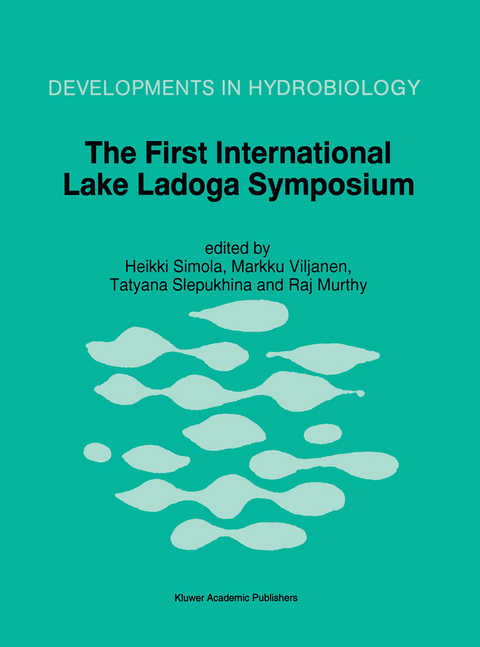
The First International Lake Ladoga Symposium
Springer (Verlag)
978-0-7923-3972-4 (ISBN)
The first international Lake Ladoga Symposium was held in St. Petersburg on 22-26 November, 1993. The symposium was attended by 160 scientists, and about half of the papers presented at the symposium have been edited for this book. The contributions are grouped under the following headings: Present state of Lake Ladoga; Hydrodynamics of Lake Ladoga and other large water bodies; Water quality and pollution; Ecological studies of Lake Ladoga biota; History of Lake Ladoga and rates of change in its environment; Research methods for large lakes. Besides providing up-to-date information on the state of the lake, the papers deal with studies of many other large lakes of the cold-temperature zone and the general problems and methods of large lake research. Furthermore, the book is a valuable source of reference to the voluminous Russian limnological literature.
Present state of Lake Ladoga.- Ecological problems of Lake Ladoga: causes and solutions.- The trophic state of Lake Ladoga as indicated by late summer phytoplankton.- Bacterioplankton response to eutrophication in Lake Ladoga.- Bottom sediments and biocoenoses of northern Ladoga and their changes under human impact.- Meiofauna of the profundal zone of the northern part of Lake Ladoga as an indicator of pollution.- Littoral zone of Lake Ladoga: ecological state evaluation.- Invertebrate communities associated with macrophytes in Lake Ladoga: effects of environmental factors.- Fishery of Lake Ladoga — past, present and future.- Hydrodynamics of Lake Ladoga and other large water bodies.- New morphometrical data of Lake Ladoga.- Main features of the thermal regime of Lake Ladoga during the ice-free period.- Numerical modelling of large-scale ciruclation in Lakes Onega and Ladoga.- Density structure of the fine surface water layer of large lakes and remote measurement of the temperature.- Physical limnological processes under ice.- Mixing in ice-covered lakes.- The influence of seasonal and year-to-year variability of water discharge from the Lake Ladoga — Neva River system on the salinity regime of the Baltic Sea.- The estimation of current state of Lake Ladoga using mathematical models.- Particle pathways of Niagara river water in Lake Ontario affecting bottom sediment contamination.- Water currents and spreading of river load in Lake Pyhäselkä, Saimaa, Finland.- Water quality and pollution.- Joint Russian—Finnish study of radioactive contamination in the NW part of Lake Ladoga.- Distribution and release of sedimentary phosphorus in Lake Ladoga.- Ecologic and hygienic evaluation of Lake Ladoga as a source of drinking water.- Lake Ladoga: chemical pollution andbiochemical self-purification.- A survey on toxicity of cyanobacterial blooms in Lake Ladoga and adjacent water bodies.- Mathematical model for the ecosystem response of Lake Ladoga to phophorus loading.- The impact of effluents of Pitkäranta pulp mill on the water quality of Lake Ladoga: a model study.- Protein indication method in monitoring of pulp mill effluent pollution in Lake Ladoga.- Ecological studies of Lake Ladoga biota.- Zooplankton characteristics in monitoring of Lake Ladoga.- Species composition of planktonic Rotifera, Cladocera and Copepoda in the littoral zone of Lake Ladoga.- Establishment of the Baikalian endemic amphipod, Gmelinoides fasciatus Stebb. in Lake Ladoga.- The Ladoga seal (Phoca hispida ladogensis Nordq.).- History of Lake Ladoga and rates of change in its environment.- Late- and postglacial history of lakes of the Karelian Isthmus.- Shoreline displacement of Lake Ladoga — new data from Kilpolansaari.- Lake Ladoga Region: human impacts and recent environmental changes.- Atmospheric deposition of sulphur, nitrogen and base cations in Scots pine stands of southeastern Finland and the Karelian Isthmus, NW Russia in 1992.- Research methods for large lakes.- Combined application of remote sensing and in situ measurements in monitoring environmental processes.- Combined use of spectral brightness and polarization characteristics of upward radiation in remote sensing of inland waterbodies.- Mathematical modelling of runoff and material transport from drainage areas into recipient water bodies.- Water chemistry of Lake Ladoga and Russian—Finnish intercalibration of analyses.- Comparison of methods used in zooplankton sampling and counting in the joint Russian—Finnish evaluation of the trophic state of Lake Ladoga.- Phytoplanktoncomposition and pigment concentrations as indicators of water quality in the Rybinsk reservoir.- The relationship between fish yield and primary production in large European freshwater lakes.- Spatial patterns and relationships between phytoplankton, zooplankton and water quality in the Saimaa lake system, Finland.- Structural phase diagrams of animal communities in assessment of freshwater ecosystem conditions.- Palaeolimnological analyses as information source for large lake biomonitoring.- Comparison of sampling methods for semipelagic animals in two deep basins of Lake Saimaa.- Sample size in the monitoring of benthic macrofauna in the profundal of lakes: evaluation of the precision of estimates.- Author index.
| Reihe/Serie | Developments in Hydrobiology ; 113 |
|---|---|
| Zusatzinfo | XII, 328 p. |
| Verlagsort | Dordrecht |
| Sprache | englisch |
| Maße | 210 x 279 mm |
| Themenwelt | Naturwissenschaften ► Biologie ► Limnologie / Meeresbiologie |
| Naturwissenschaften ► Biologie ► Ökologie / Naturschutz | |
| ISBN-10 | 0-7923-3972-X / 079233972X |
| ISBN-13 | 978-0-7923-3972-4 / 9780792339724 |
| Zustand | Neuware |
| Haben Sie eine Frage zum Produkt? |
aus dem Bereich


